Unit3Traveljournal[教案]
- 格式:docx
- 大小:24.93 KB
- 文档页数:4
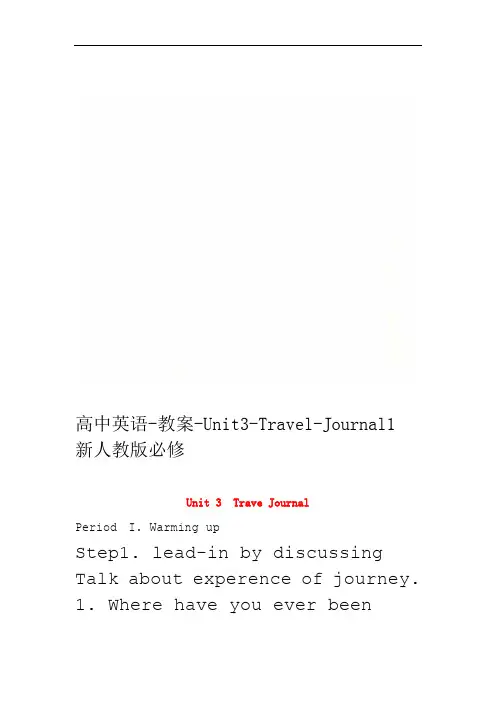
高中英语-教案-Unit3-Travel-Journal1新人教版必修Unit 3 Trave JournalPeriod I. Warming upStep1. lead-in by discussing Talk about experence of journey.1. Where have you ever beenbefore/ in theNational Day?2. How do you like the travel to…? (eg: I have been Beijing during holiday. It isvery interesting that … Wevisit … and found…That journey helps me know the culture therebetter.)3. Why do you think the journey is helpful?To …(to brunden our horizons; to learn moreabout local culture and history; to relax; to makefriends; to get a better understanding of…)Step2. Warming upTask1. Part 1 on Page171. If you want to go travelling, where are yougoing? How did you get there? (on foot; by bike; by bus; by car/jeep; by train;by plane/by air; by boat/byship/by sea)2. If you are given a chance to travel around the2use will you world, what kind of transportationsand why?you before have (What do you to consideruse? will which means of transport you decide)/ Comfort (舒适)/ Cost(花费Safety(安全)/))Quickness/ Convenience (方便3. Now look at the following chart on Studentbookand discuss it in your group. (Discussion Making note Grouping sentencesSpeech )2 Task2. Part1. Where are you going on on Page 17 holiday?Make dialogues 2. When are you leaving? are When A: 3. How are you goingyou leaving?B: I am leaving…Sample dialogueA: Tom, where are you going on holiday?B: I'm going to Laos.A: When are you leaving?B: I am leaving next Sunday.3A: How are you going to Laos? B: I'm taking a plane.A: How long are you staying inLaos?B: I am staying there about two weeks.A: Great. Have a good trip.B: Thanks.Step3. Homework1. Make a speech (workbook)2.导学大课堂P67-68/课前导读Period II. Reading(1)Step1. RevisionMake a speech on Page55 Workbook Step2. Lead-in1. Do you like traveling along a river, a greatriver? What role does a river play in people'slife? In other words, how do people who livealong a river use it?The suggested answers:People can drink the water in a river or washtheir clothes.People can swim in a river in summer.4People can use a river to irrigate their fields.People can use a river to produce electricity. People can travel along a river.2. Where there is a river, there is a city.the rivers in are a lot of As we all know, thereworld and also there are manygreat rivers. Nowcolumn are names look at the chart. In the leftare right column rivers. In the of some greatmatch lie. Please where the rivers locationsthem.Location Names of RiverRhine SE Asia /ChinaMekong ,India/Ganges Germany /Egypt/ France / Nile SeineEngland/ThamesNiger West Congo CentralAfrica/Russia/Volga Africa/Amazon Danube Central Europe/US/Brazil/ MississippiStep 3. Pre-reading 3 on page17 Now look at the map of the Mekong River andpoint out the countries it flows through.5(China, Laos, Thailand, Cambodia, BurmaVietnam)Step 4. Reading1.Skimming. Find out the main ideas of eachparagraph.Para.1 Wang Kun and Wang Wei's dream.Para.2 Wang Wei is stubborn. Para.3 Preparing for their trip.2.Careful reading. Answer the queations of part1 on P19 \《导学大课堂》课前导读1)Who are Wang Kun and Wang Wei? (Theyare brother and sister, and both are collegestudents.)2)What was their dream? (Their dream was totake a great bike trip.)3)Who are Dao Wei and Yu Hang? (They areWang Kun's cousins who are at a college inKunming.)4)Where is the source of the Mekong River andwhich sea does it enter?(The source of theriver is in Qinghai Province and it enters theSouth China Sea.)65)What can you see when you travel along the Mekong?(You can see glacier, rapids, hill, valleys, waterfallsand plains.)6)Is it a difficult journey to cycle along theMekong? Why? (Yes. The journey begins atan altitude of more than 5,000 meters, whereit is hard to breathe and very cold.)3.Sentences patterns.1. Ever since middle school, my sister Wang Weiand I have dreamed about taking a great biketrip. 从中学起, 我姐姐王薇和我梦想作一次了不起的自行车旅行。
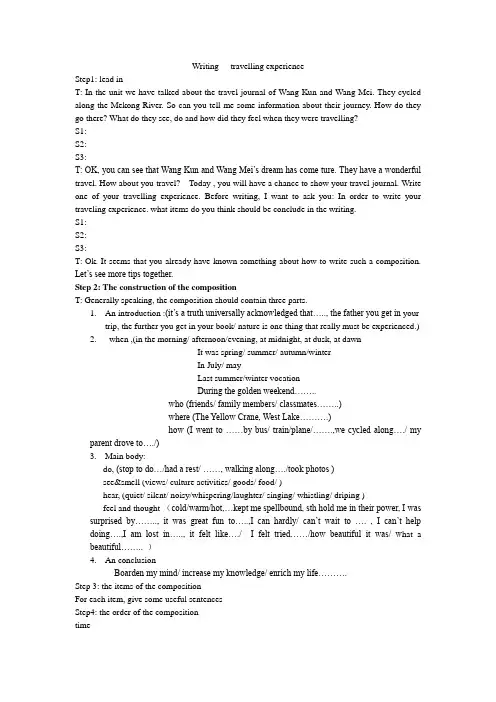
Writing----travelling experienceStep1: lead inT: In the unit we have talked about the travel journal of Wang Kun and Wang Mei. They cycled along the Mekong River. So can you tell me some information about their journey. How do they go there? What do they see, do and how did they feel when they were travelling?S1:S2:S3:T: OK, you can see that Wang Kun and Wang Mei’s dream has come ture. They have a wonderful travel. How about you travel? Today , you will have a chance to show your travel journal. Write one of your travelling experience. Before writing, I want to ask you: In order to write your traveling experience. what items do you think should be conclude in the writing.S1:S2:S3:T: Ok. It seems that you already have known something about how to write such a composition. Let’s see more tips together.Step 2: The construction of the compositionT: Generally speaking, the composition should contain three parts.1.An introduction :(it’s a truth universally acknowledged that….., the father you get in yourtrip, the further you get in your book/ nature is one thing that really must be experienced.)2.when ,(in the morning/ afternoon/evening, at midnight, at dusk, at dawnIt was spring/ summer/ autumn/winterIn July/ mayLast summer/winter vocationDuring the golden weekend……..who (friends/ family members/ classmates……..)where (The Yellow Crane, West Lake……….)how (I went to ……by bus/ train/plane/…….,we cycled along…./ my parent drove to…./)3.Main body:do, (stop to do…/had a rest/ ……, walking along…./took photos )see&smell (views/ culture activities/ goods/ food/ )hear, (quiet/ silent/ noisy/whispering/laughter/ singing/ whistling/ driping )feel and thought (cold/warm/hot,…kept me spellbound, sth hold me in their power, I was surprised by…….., it was great fun to…..,I can hardly/ can’t wait to …. , I can’t help doing….,I am lost in….., it felt like…./ I felt tried……/how beautiful it was/ w hat a beautiful…….. )4.An conclusionBoarden my mind/ increase my knowledge/ enrich my life……….Step 3: the items of the compositionFor each item, give some useful sentencesStep4: the order of the compositiontimeplaceYou should not just set down a series of facts. Step5: notes1: what kind of composition it is? Narrative 2: what’s the tense past tense。
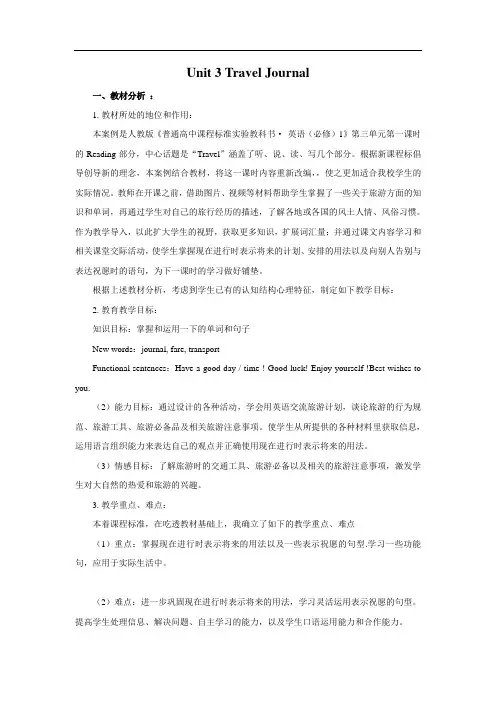
Unit 3Travel Journal一、教材分析:1. 教材所处的地位和作用:本案例是人教版《普通高中课程标准实验教科书·英语(必修)1》第三单元第一课时的Reading部分,中心话题是“Travel”涵盖了听、说、读、写几个部分。
根据新课程标倡导创导新的理念,本案例结合教材,将这一课时内容重新改编,,使之更加适合我校学生的实际情况。
教师在开课之前,借助图片、视频等材料帮助学生掌握了一些关于旅游方面的知识和单词,再通过学生对自己的旅行经历的描述,了解各地或各国的风土人情、风俗习惯。
作为教学导入,以此扩大学生的视野,获取更多知识,扩展词汇量;并通过课文内容学习和相关课堂交际活动,使学生掌握现在进行时表示将来的计划、安排的用法以及向别人告别与表达祝愿时的语句,为下一课时的学习做好铺垫。
根据上述教材分析,考虑到学生已有的认知结构心理特征,制定如下教学目标:2. 教育教学目标:知识目标:掌握和运用一下的单词和句子New words:journal, fare, transportFunctional sentences:Have a good day / time ! Good luck! Enjoy yourself !Best wishes to you.(2)能力目标:通过设计的各种活动,学会用英语交流旅游计划,谈论旅游的行为规范、旅游工具、旅游必备品及相关旅游注意事项。
使学生从所提供的各种材料里获取信息,运用语言组织能力来表达自己的观点并正确使用现在进行时表示将来的用法。
(3)情感目标:了解旅游时的交通工具、旅游必备以及相关的旅游注意事项,激发学生对大自然的热爱和旅游的兴趣。
3. 教学重点、难点:本着课程标准,在吃透教材基础上,我确立了如下的教学重点、难点(1)重点:掌握现在进行时表示将来的用法以及一些表示祝愿的句型.学习一些功能句,应用于实际生活中。
(2)难点:进一步巩固现在进行时表示将来的用法,学习灵活运用表示祝愿的句型。
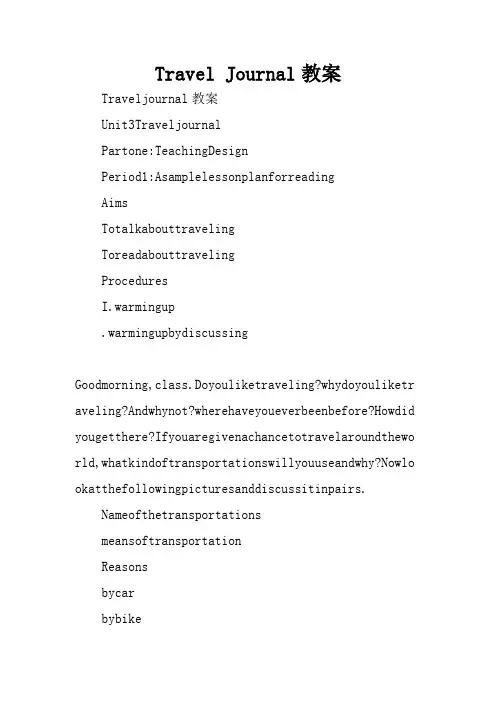
Travel Journal教案Traveljournal教案Unit3TraveljournalPartone:TeachingDesignPeriod1:AsamplelessonplanforreadingAimsTotalkabouttravelingToreadabouttravelingProceduresI.warmingup.warmingupbydiscussingGoodmorning,class.Doyouliketraveling?whydoyouliketr aveling?Andwhynot?wherehaveyoueverbeenbefore?Howdid yougetthere?Ifyouaregivenachancetotravelaroundthewo rld,whatkindoftransportationswillyouuseandwhy?Nowlo okatthefollowingpicturesanddiscussitinpairs.NameofthetransportationsmeansoftransportationReasonsbycarbybikebyplanebytrainbybusbyshipinahotballoonbymotorbikebyjeepbytruckinaplate2.warmingupbylookingandspeakingNowboysandgirls,whatdoyouneedtotakewithyouifyouarep reparingforabiketripalongthechangjiangRiver?Lookatt hepicturesandtellthewholeclasswhichobjectyouthinkis themostusefulandwhichoneistheleastuseful.Giveareaso nwhyyouthinkso.3.warmingupbyaskingandansweringNowsupposeyouliveinQinghai.youplantospendaholidaywi thafriendsomewhereinSoutheastAsia.youhavebeengivena chancetochoosethreeplacestovisit.Pleasefindouttheon e-wayfaretogettherefordifferentkindsoftransportation.Perhapsyoumaynotknowtheexactfare,butyoucanguessho wmuchthefareis.Pleasehaveashortdiscussionwithyourpa rtnersandthendecidewheretogo.ok,nowI’dlikeyoutoaskyourpartnerthefollowingquestions.II.Pre-reading.ImagingandsharingDoyouliketravelingalongariver,agreatriver?whatroledoesariverplayinpeople’slife?Inotherwords,howdopeoplewholivealongariveruse it?Thesuggestedanswers:Peoplecandrinkthewaterinariverorwashtheirclothes.Peoplecanswiminariverinsummer.Peoplecanusearivertoirrigatetheirfields.Peoplecanusearivertoproduceelectricity.Peoplecantravelalongariver.2.TalkingandsharingAsweallknow,therearealotofriversintheworldandalsoth erearemanygreatrivers.Nowlookatthechart.Intheleftcolumnarenamesofsomegreatrivers.Intherightcolumnarelo cationswheretheriverslie.Pleasematchthem.matchanswerNamesofRiverLocationNamesofRiverLocationmekongIndiamekongchina,SEAsiaRhineFranceRhineGermanyGangesRussiaGangesIndiaSeineEnglandFranceNile centralAfrica NileEgypt Thames Germany Thames England congoBrazilcongo centralAfrica Nigerchina,SEAsia Niger westAfrica VolgaUSVolgaRussiaEgyptDanubecentralEuropeAmazonwestAfricaAmazonBrazilmississippicentralEuropemississippiUSIII.Reading.ReadingaloudtotherecordingDoyouknowwhatcountriesthemekongRiverflowsthrough?No wlookatthemapofthemekongRiverandpointoutthecountrie sitflowsthrough.ok,todaywe’regoingtoreadapassageaboutjoURNEyDowNTHEmEkoNG.Plea selistenandreadaloudabouttherecordingofthetextjoURN EyDowNTHEmEkoNG.Payattentiontothepronunciationofeachwordandthepauseswithineachsentence.Iwillplaythetap etwiceandyoushallreadaloudtwice,too.2.ReadingandunderliningNowpleasereadandunderlinealltheusefulexpressionsorc ollocationsinthepassage.copythemtoyournotebookafter classashomework.collocationsfromjoURNEyDowNTHEmEkoNGdreamabout,takeagreatbiketrip,graduatefrom,gotthech ancetodosth.,cyclealongtheriver,goforlongbikerides, mountainbike,persuadesb.todosth.,growup,getsb.inter estedinsth.,bestubborn,knowthebestwayofgettingtopla ces,thesourceoftheriver,careabout,givesb.adetermine dlook,changeone’smind,atanaltitudeof,seemtodo,theairbehardtobreathe ,aninterestingexperience,makeuponesmind,givein,alar geatlaswithgoodmaps,keepdoingsth.,atfirst,passthrou gh,besurprisedtodosth.,halfof,atlast,theSouthchinaS ea3.ReadingaloudandunderstandingNextwearegoingtoreadaloudthetextandthenanswersomequ estions.)whoarewangkunandwangwei?2)whatwastheirdream?3)whoareDaoweiandyuHang?4)whereisthesourceofthemekongRiverandwhichseadoesiten ter?5)whatcanyouseewhenyoutravelalongthemekong?6)Isitadifficultjourneytocyclealongthemekong?why?4.Discussingwehavegotthegeneralmeaningofthepassage,andweknowwan gweiandwangkunhavesomesimilaranddifferentattitudesa boutthetrip.youmayhaveashortdiscussionwithyourpartn ersandthenfillinthechart.SimilarattitudesaboutthetripDifferentattitudesaboutthetripBothwangweiandwangkunthinks:).takingthistripisadreamthatcomestrue.2).thattheywillenjoythistripalot.3).theyshouldseealotofthemekong.4).thatmostofthemekongwillbefoundinSoutheastAsia.wangweibelieves:).theymuststartinQinghaiwheretheriverbegins/see allofthemekong.2).thattheydon’tneedtopreparemuch.wangkunbelieves:).itistoocoldandhightostartinQinghai.2).thatusinganatlasisveryimportant.IV.closingdownclosingdownbyansweringquestionswhatshouldyoudobeforetraveling?whatwillyourfamilyandyourfiendssaywhenyouleavehomet otravel?closingdownbytranslatingInthelastfewminutesyouareaskedtotranslatesomediffic ultysentencesinthepassage.AssignmentRevisethecontentsofthepassagecompletethepassageonPage56inworkbookDoexercise2onpage57inyouexercisebooks.Period2:AsamplelessonplanforLearningaboutLanguage AimsTolearnaboutthePresentcontinuousTenseTodiscoverandusesomeusefulwordsandexpressionsProceduresI.warmingupwarmingupbydiscoveringusefulwordsandexpressionsHelloeveryone.Afterreadingthepassage,wehavegottokno wtheusageofthewordsandexpressions,butweshoulddomorepractice.Nowturntopage20tofindthecorrectwordsandexp ressionsfromthepassagetofinishthesentences.youaregi ventwominutestofinishthemanddiscusswithyourpartners .Twominuteslater,checkinpairsandthencheckwiththewho leclass.II.Learningaboutlanguage.ReadingandfindingGood,youhavemasteredthesewordsandexpressions.Let’sturntopage17andlookatthequestionsinwarmingup4.Unde rlinetheverbsinthequestions,andpayattentiontothever bformsanddosomeexplanationsbyyourselves.2.LearningGrammarwecanseethattheverbsareallusedinthe“-ing”form.Theyare“thepresentcontinuoustense”,buttheyexpressfuturea ctionsorplans.ThePresentcontinuousTensemaybeusedtod enoteanactionthatcanbepre-plannedorprearrangedinste adofthefutureindefiniteincolloquialEnglish.Butpleas enotethat,notallverbscanbeusedinthe“-ing”formtoexpressfutureactions.Suchverbsascome,go,leave ,fly,walk,ride,drive,stay,meet,die,see,have,arriveetc.aremainlyusedinthe“-ing”formtoexpressfutureactions.3.DoingexercisesNo.2and3onpage21Nowturntopage21anddoexercise2.Inthedialogueanewspap erreporterisinterviewingwangweiaboutherplansforthet ripalongthemekongRiver.However,theyarenotsureabouts omeoftheverbtenses.canyouhelpthemcompletetheirconve rsation?Let’scontinuetodoexercise3.Doyouhaveanyplansforthefutur eyourselves?Ifyouhaveany,pleaseusethePresentcontinu ousTensetoexpressyourfutureactions.Giveasmuchinform ationasyoucan.III.Readyusedmaterialsforthepresentcontinuoustensef orfutureactionsorplansbe+v.-ing与表示将来的时间连用,表示不久的将来,含义是“预定要做”。
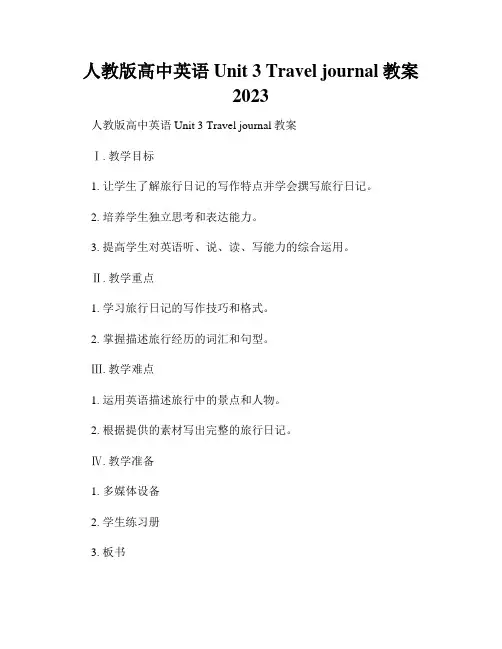
人教版高中英语Unit 3 Travel journal教案2023人教版高中英语Unit 3 Travel journal教案Ⅰ. 教学目标1. 让学生了解旅行日记的写作特点并学会撰写旅行日记。
2. 培养学生独立思考和表达能力。
3. 提高学生对英语听、说、读、写能力的综合运用。
Ⅱ. 教学重点1. 学习旅行日记的写作技巧和格式。
2. 掌握描述旅行经历的词汇和句型。
Ⅲ. 教学难点1. 运用英语描述旅行中的景点和人物。
2. 根据提供的素材写出完整的旅行日记。
Ⅳ. 教学准备1. 多媒体设备2. 学生练习册3. 板书Ⅴ. 教学过程Step 1. 导入新课1. 向学生介绍旅行日记的概念和重要性。
提问:你们曾经写过旅行日记吗?为什么要写旅行日记?2. 呈现一份标准的旅行日记,并让学生观察其中的格式和写作技巧。
Step 2. 学习旅行日记的格式和写作技巧1. 提示学生观察旅行日记的格式,包括日期、地点、时间、内容等。
2. 引导学生观察旅行日记的语言风格,如使用第一人称、过去时态等。
3. 教授一些描述旅行经历的词汇和句型,如visit, explore, enjoy, beautiful scenery等。
Step 3. 练习写作1. 分发学生练习册,并让学生完成练习册上的相关写作练习。
2. 引导学生分享自己的旅行经历并写成日记。
学生可以根据提供的素材写,也可以自由发挥。
3. 让学生交换日记,互相阅读并提供建议和修改意见。
Step 4. 总结和拓展1. 让学生总结本节课学到的旅行日记的写作技巧和格式。
2. 提供更多的写作素材和练习,让学生进一步拓展写作能力。
Ⅵ. 作业布置1. 练习册上的写作练习。
2. 要求学生继续写作旅行日记,并根据教师的要求反馈修改。
3. 准备下节课的教材和学习资料。
以上就是针对人教版高中英语Unit 3 Travel journal教案的教学内容和流程安排。
希望学生们通过本节课的学习能够熟悉旅行日记的写作特点,掌握相关的词汇和句型,并能够在实际写作中灵活运用。
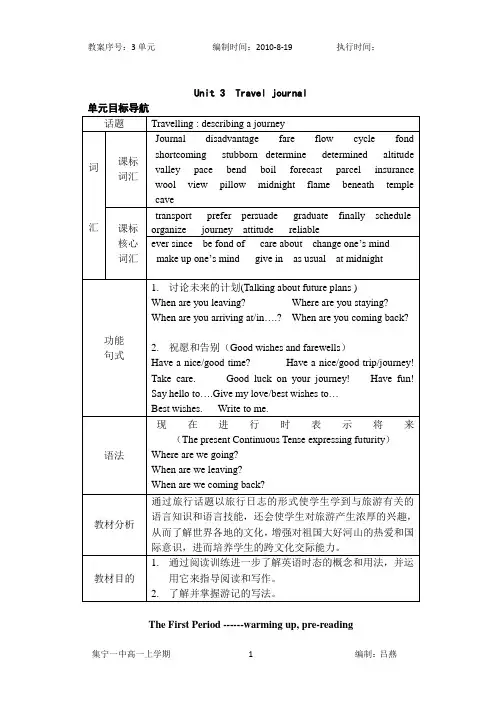
Unit 3 Travel journalThe First Period ------warming up, pre-readingTeaching aims:1.To talk about the advantages and disadvantages of transports.2.To talk about future plans about holidays.3.To talk about something about rivers.Teaching important and difficult points:To help students talk in English about traveling.Teaching proceduresStep1. Lead-in:Hello everyone. Do you like traveling? Where have you ever been before? How did you get there? If you are given a chance to travel around the world, what kind of transportations will you use?Step2. Warming up:1.Yes. There are so many kinds of transports we can choose to travel, but why do you choose this one not the others. Think about the advantages and disadvantages of each form of transport and fill in the following chart. Suggested answers to Exercise:2. Imagine that you plan to spend a holiday. Choose a place you want to visit. Think about the fare for different kinds of transport and decide how to get there. Then, get into pairs. Use these questions on P17 to make a dialogue about your holidays.Sample dialogue:S1: I’ve planned a trip for my holiday.S2: OK. Where are you going?S1: Lijiang and Dali in Y unnan.S2: Lovely. How are you getting there?S1: As I haven’t much time I think I need to travel by air.S2: That’s going to be very expensive. How much is the fare?S1: About 1,500 yuan.S2:When are you leaving?S1: One week after school finishes for this year.S2: Sounds good to me. Where are you staying?S1: I’d like to stay in local homes.S2: That sounds fun. How long are you staying in Lijiang and how long in Dali?S1: I’m thinking of staying two nights at each place.S2: That’s good. When are you coming back?S1: Five days after I get off.S2: Great. Good luck on your journey!Step3. Pre-reading:1. Imaging and sharingDo you like traveling along a river, ? What role does a river play in2. Talking and sharingAs we all know, there are a lot of rivers in the world and also there are many great rivers. Now look at the chart. In the left column are names of some great rivers. In the right column are locations where the rivers lie. Please match them.Step4. Language points:1.one-way fare / single-way fare (单程票价), round-way fare (往返/双程票价)2. different kinds of transport (Br.E) / transportation(Am.E)3. prefer v.(preferred/preferring)更喜欢,选择某事物(而不选择其他事物)e.g.1). I prefer dogs to cats. 猫狗之中我更喜欢狗。
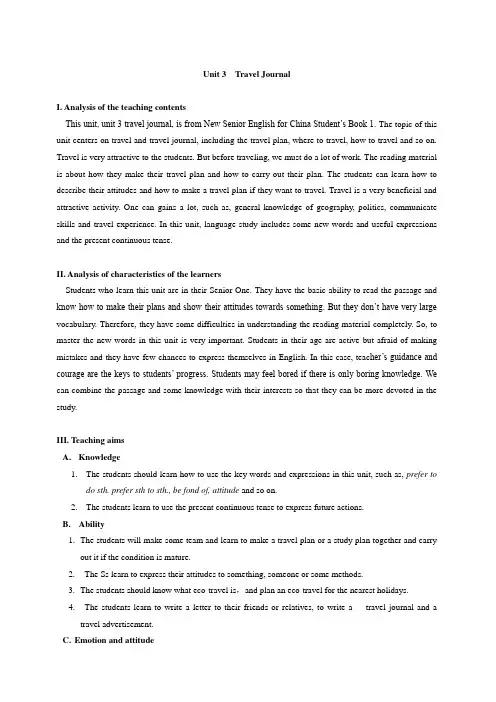
Unit 3 Travel JournalI. Analysis of the teaching contentsThis unit, unit 3 travel journal, is from New Senior English for China Student’s Book 1. The topic of this unit centers on travel and travel journal, including the travel plan, where to travel, how to travel and so on. Travel is very attractive to the students. But before traveling, we must do a lot of work. The reading material is about how they make their travel plan and how to carry out their plan. The students can learn how to describe their attitudes and how to make a travel plan if they want to travel. Travel is a very beneficial and attractive activity. One can gains a lot, such as, general knowledge of geography, politics, communicate skills and travel experience. In this unit, language study includes some new words and useful expressions and the present continuous tense.II. Analysis of characteristics of the learnersStudents who learn this unit are in their Senior One. They have the basic ability to read the passage and know how to make their plans and show their attitudes towards something. But they don’t have very large vocabulary. Therefore, they have some difficulties in understanding the reading material completely. So, to master the new words in this unit is very important. Students in their age are active but afraid of making mistakes and they have few chances to express themselves in English. In this case, teac her’s guidance and courage are the keys to students’ progress. Students may feel bored if there is only boring knowledge. We can combine the passage and some knowledge with their interests so that they can be more devoted in the study.III. Teaching aimsA.Knowledge1.The students should learn how to use the key words and expressions in this unit, such as, prefer todo sth. prefer sth to sth., be fond of, attitude and so on.2.The students learn to use the present continuous tense to express future actions.B.Ability1.The students will make some team and learn to make a travel plan or a study plan together and carryout it if the condition is mature.2.The Ss learn to express their attitudes to something, someone or some methods.3.The students should know what eco-travel is,and plan an eco-travel for the nearest holidays.4.The students learn to write a letter to their friends or relatives, to write a travel journal and atravel advertisement.C.Emotion and attitude1.Develop Ss’ sense of eco-travel and make them protect the environment while traveling.2.The students will learn that travel also need courage, perseverance and some common sense.3.They will develop students’ cooperative spirit.IV. Teaching methodologyGenerally, the method is task-based language teaching. Details are as follows:1.Discussion to help the students know something about travel: the transport, the travel budget. Picturesto show the natural environment of the Mekong river.2.Fast reading to help the students to get the general idea of the passage.3.Careful reading to get the students to understand some detailed information.4.Pair work to develop the students’ cooperative spirit and encourage them to speak English in class.5.Retell to help students to review the passage .V. Learning strategyVI. Important points of teaching1.Master the new words and phrases in this unit.2.Help the students to get a better understanding of the text.3.Help the students to make a prese ntation on one’s own travel plan.VII. Difficult point of teaching1.Express fluently their travel plan and wishes.2.Grasp the main idea of the text and how to tell the writer’s attitude.3.Plan an eco-travel for the nearest holiday.VIII. Teaching proceduresStep 1. Warming upShow some beautiful pictures around the worldGoal: This step is to arouse the students’ interest in the unit.Step2. Background informationLet the students’ say something about travel and the Mekong River and then, teacher will give some pictures of the Mekong River.Goal: To enrich their background knowledge.Step3: ReadingA.Pre-readingB.While-readingC.Post-readingGoal: Improve the students’ ability of exchanging ideas and let them get the general idea of the given passage through skimming and scanning. And gain the knowledge of some common sense and the words, phrases and grammar points.Step4: ExercisesGoal: Do some exercises to review what have learned before. Pair work to tr ain students’ ability of speaking and cooperative spirit.Step5: HomeworkGoal: To let the students consolidate what they have learnt and improve their writing ability.Step6: SummaryIX. Teaching contents1.Lead-in and Warming-upShow some pictures or postcards of some places of interest and beautiful travel destinations and vocation resorts on the screen and tell them the places of interests in the world. And then ask them if they like traveling. They may answer yes, and I continue to ask where they have been.T: Ok, boys and girls, do you like traveling?Ss: Yes.T: Where have you been before? And how did you find your travel?Possible answers:(Here the students’ answers are probably different. They may answer that they have been to Beijing, Shanghai, Guangzhou, Qingdao, Fuzhou, Xiamen and some other place. And they may find their travel is interesting, funny, impressive, unforgettable, wonderful, comfortable and so on.)(In 3-4 minutes)Then I tell them that on this National Day I paid a visit on Shanghai with my friends. We visited Oriental Pearl,which is the nickname of Shanghai. It took me 10 hours to get there by train. What’s more, I spent a lot of money for this travel. Then show the pictures of Oriental Pearl and Huangpu River to the students on the screen. And present a table about the fare, the transport, the date, and the destination on the screen.However, what’s more important, I learned a lot from this travel. Not only could I enjoy the places of interest, but also I could learn about many local customs, cultures and the history of some places of interest. So I think it is very interesting and helpful.Meanwhile, with the help of multimedia, I’ll also show some pictures of different kinds of transports and help the students to revise them, including by car, by bus, by ship, by train, by air etc. However, each transport has its own advantages and disadvantages. Now please list some advantages and disadvantages of each transport after discussion with your partners. (In3 minutes or so)Then I will ask some of them to show their answers. At last, I summarize and present the main answers on the screen. (In 4 minutes or so)Who are you going with?How are you traveling?Which river will you choose?What will you prepare?From where will you start?When are you coming back?Step2 Background informationWith the help of multimedia, I’ll show some pictures of the Mekong River and introduce the basic information, such as the length, the countries that it flows through, where it ends, how it looks like and so on. Also, I will help the students to revise the transports and asked them if we want to travel the Mekong River, what transports should we choose.The Mekong is a river in Southeast Asia. It is the world's 12th-longest river and the 7th-longest in Asia. Its estimated length is 4,350 km (2,703 mi),and it drains an area of 795,000 km2(307,000 sq mi), discharging 475 km3 (114 cu mi) of water annually.From the Tibetan Plateau this river runs through China's Yunnan province, Burma, Laos, Thailand, Cambodia and Vietnam. Laos, Thailand, Cambodia and Vietnam established the Mekong River Commission (MRC) in 1995 to assist in the management and coordinated use of the Mekong's resources. In 1996 China and Burma became "dialogue partners" of the MRC and the six countries now work together within a cooperative framework.The extreme seasonal variations in flow and the presence of rapids and waterfalls in this river have made navigation difficult. Two hundred Chinese border police and 100 policemen from Myanmar, Laos and Thailand escorted a convoy of 10 Chinese cargo ships departing Guanlei, China, recently. The river is a major trading route linking China’s southwestern province of Yunnan to the South China Sea via Myanmar, Laos, Thailand, Cambodia and Vietnam, and provides locals with an invaluable outlet to the sea and international trading.Step3 Reading1.Pre-readingCan you guess what the names of these rivers are? (In 1 minute)Changjiang (Yangtze) Yellow2.3.4.5.6.7.8.9.Nile AmazonHow do people living along a river make use of it? (Individual work in this part)To irrigate the fieldsTo go swimming in it in summerTo make electricityTo travel along itOk, now please look at the map on page 18 and list the countries that the Mekong River flows through. (review)Mekong RiverThe countries that the Mekong River flows through: China's Yunnan province, Burma, Laos, Thailand,Cambodia and Vietnam2.While-readingAsk the students to scan the text and think about the following questions.A.What Is the text about?B.What was Wang Kun and Wang Wei’s idea of a good trip?Their idea was to take a long bike trip.C.Who planned the trip to the Mekong?Wang Wei.Ask the students to read the text more carefully and answer more questions.D.Where is the source of the Mekong River and which sea does it enter?The source of the river is in Qinghai Province and it enters the South China Sea.E.What can you see when you travel along the Mekong River?You can see glacier, rapids, hills, valleys, waterfalls and plains.F.What difficulties did Wang Kun and Wang Wei find about their journey?The journey will begin at an altitude of more than 5,000 metres, where it is hard to breathe and very cold.G.What do you think about Wang Kun and Wang Wei?Wang Kun is enthusiastic, critical, and sensible, while Wang Wei is imaginative, organized, eager, persistent, stubborn and risk-taking.3.Post-readingA.After they complete these questions, I’ll ask the students to read the text following the tape. And thenunderline the difficult sentences and some important expressions and phrases. Then I will explain then in next class.B.Ask the students to simply retell the story in their own word and then tell others Wang Kun’s and WangWei’s attitudes to this journey.Step 4: Exercisesnguage exercises: Discovering useful words and expressions, Discovering useful structures.B.Work in pair. Imagine that you are Wang Kun or Wang Wei. Choose a paragraph from the passage anduse the information to help you make up a dialogue.Wang Wei: You know, we’ve always wanted to do a long bike trip. Why don’t we go on after we graduate from college?Wang Kun: That is a good idea. …Step 5: HomeworkWrite a short passage of your travel plan.Step6. SummaryNow, let’s sum up what you have learnt about traveling.From this unit, you have also learned:Useful words:Useful phrases:A new grammar item:Other ability that you have gained:。
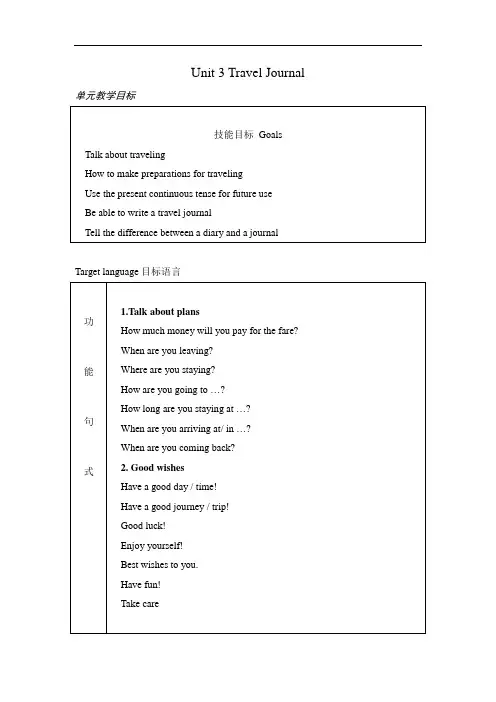
Unit 3 Travel Journal 单元教学目标Target language目标语言Ⅲ教材分析与组合1 教材分析本单元以travel为主题,使学生通过travel了解他们所去国家或地区的风土人情,地理地貌及气候特征。
让学生体会英语作为工具给他们带来的乐趣。
学生可以利用英语扩大自己的视野,获取知识,了解世界。
学生可以通过相互讨论和相互交流以丰富各自的地理知识。
进一步扩大学生的词汇量。
能正确使用现在进行时的形式表达将来的计划和安排。
本单元把Travel Down the Mekong分成六部分,其中三部分作为阅读材料而另三部分作为听力材料。
通过本单元的学习使学生掌握一些重要词汇及词组,并能够写出自己的旅行日志来提高自己的写作水平。
1.1 Warming-up 让学生想象去旅游并选择一个地方为题,讨论所需费用,并决定四种交通方式,使学生了解旅行前的准备及计划。
1.2 Pre-reading 部分的三个问题是通过讨论河流在人民生活中的作用以及看图回答问题,让学生找到湄公河流域的国家,作为阅读的“热身”1.3 Reading 是日志的第一部分,它讲述了王坤和王薇的骑车旅行梦想和计划,描述了他们为这次旅游所做的准备,对旅游路线的选定以及他们通过查阅地图对湄公河情况的了解。
文章用第一人称的方式,通过对王薇做事的方式的介绍,让大家了解了她的性格特点,使人倍感亲切,给人留下深刻的印象。
日志的第二部分放在workbook 中,主要讲述他们在西藏山中度过的一宿,以及旅行中的苦与乐。
1.4 Comprehending第一题是信息题,通过问答使学生进一步理解课文以训练学生获取信息的能力。
第二题是理解题,让学生用自己的话解释课文中的句子。
第三题是推断题,让学生通过主人公的行为来推断他们对旅行的态度。
第四、五题是语言运用题,用以提高学生运用语言的能力。
1.5 Learning about language分两部分,第一部分是旨在通过三个题型的练习使学生掌握目标语言。
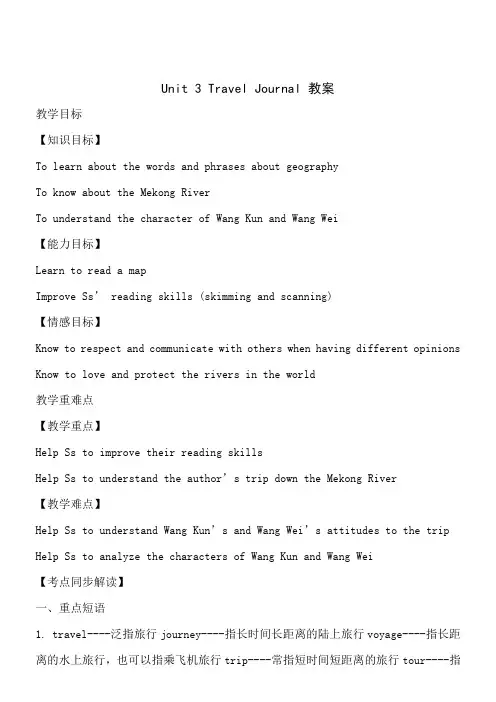
Unit 3 Travel Journal 教案教学目标【知识目标】To learn about the words and phrases about geographyTo know about the Mekong RiverTo understand the character of Wang Kun and Wang Wei【能力目标】Learn to read a mapImprove Ss’ reading skills (skimming and scanning)【情感目标】Know to respect and communicate with others when having different opinions Know to love and protect the rivers in the world教学重难点【教学重点】Help Ss to improve their reading skillsH elp Ss to understand the author’s trip down the Mekong River【教学难点】Help Ss to understand Wang Kun’s and Wang Wei’s attitudes to the trip Help Ss to analyze the characters of Wang Kun and Wang Wei【考点同步解读】一、重点短语1. travel----泛指旅行journey----指长时间长距离的陆上旅行voyage----指长距离的水上旅行,也可以指乘飞机旅行trip----常指短时间短距离的旅行tour----指周游,巡回旅游,2. prefer to 更加喜欢,宁愿 prefer A to B 比起B,更喜欢Aprefer doing to doing 比起做…,宁愿做…prefer to do rather than do 与其做…, 不如…3. flow through 流过,流经4. ever since 自从5. persuade sb. to do sth. 说服某人做某事6. be fond of 喜欢7. insist on doing 坚持做某事 insist + that 从句(用should+ V原)8. care about 关心. change one’s mind 改变想法10. altitude 高度attitude 态度,看法11. make up one’s mind to do下定决心做某事 = decide to do = make a decision to do12. give in 让步,屈服give up 放弃13. be surprised to …对…感到惊奇to one’s surprise 令某人惊讶的是…14. at last = finally = in the end 最终15. stop to do 停下来去做某事stop doing 停止做某事16. as usual 像往常一样17. so…that如此…以至于… So + adj + a/an + n. + thatSuch + a/an +adj. + n. + that18. be familiar with 对…熟悉(人作主语)be familiar to 为…所熟悉(物作主语)二、语法:现在进行时表将来现在进行时表将来,表示最近按计划或安排要进行的动作,常见的现在进行时表将来的动词有:come/ go / leave/ arrive / travel / take / stay/ do等.【核心素养聚焦】1. Encourage students to learn more about traveling and tourist culture2. Enable students to become more interested in traveling and experience the beauty of nature so as to be fond of nature.3. Train the students’ ability to cooperate with others4. Try to make the students to use some useful words and expressions correctly5. Try to make the students to review the useful sentence patterns6. Train the students to interest in learning English课前准备Tape recorder, Multimedia教学过程Step1. Warm-upA competition between groups:1)Which country is Mississippi River located in?2)Which country is Thames River located in?3)Which river is the longest river in the world?4)Which river is the second longest river in the world?5)Which river is the longest river in China?6)Which river is the most important river in Southeast Asia?【设计意图】通过小组竞赛激发学生参与课堂的积极性,并让学生了解和积累世界河流的知识,为进一步阅读理解文章做准备。
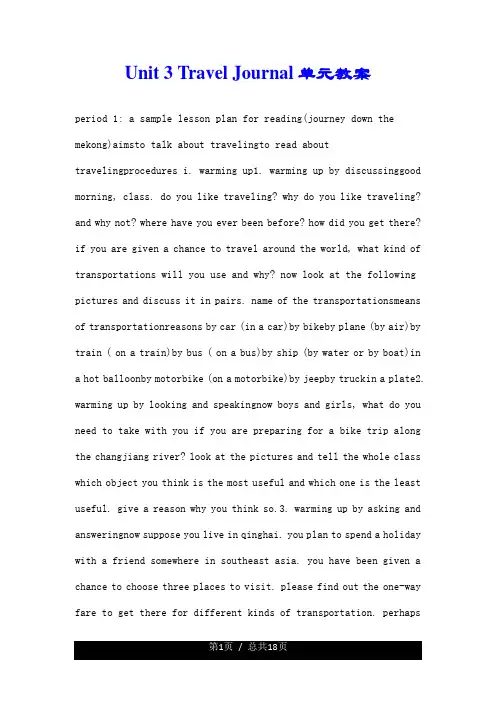
Unit 3 Travel Journal单元教案period 1: a sample lesson plan for reading(journey down the mekong)aimsto talk about travelingto read about travelingprocedures i. warming up1. warming up by discussinggood morning, class. do you like traveling? why do you like traveling? and why not? where have you ever been before? how did you get there? if you are given a chance to travel around the world, what kind of transportations will you use and why? now look at the following pictures and discuss it in pairs. name of the transportationsmeans of transportationreasons by car (in a car)by bikeby plane (by air)by train ( on a train)by bus ( on a bus)by ship (by water or by boat)in a hot balloonby motorbike (on a motorbike)by jeepby truckin a plate2. warming up by looking and speakingnow boys and girls, what do you need to take with you if you are preparing for a bike trip along the changjiang river? look at the pictures and tell the whole class which object you think is the most useful and which one is the least useful. give a reason why you think so.3. warming up by asking and answeringnow suppose you live in qinghai. you plan to spend a holiday with a friend somewhere in southeast asia. you have been given a chance to choose three places to visit. please find out the one-way fare to get there for different kinds of transportation. perhapsyou may not know the exact fare, but you can guess how much the fare is. please have a short discussion with your partners and then decide where to go. ok, now i’d like you to ask your partner the following questions.1. where are you going on holiday? 2. when are you leaving?3. how are you going to…?4. when are you arriving in/at…?5. where are you staying?6. how long are you staying there?7. when are you coming back?ii. pre-reading1. imaging and sharingdo you like traveling along a river, a great river? what role does a river play in people’s life? in other words, how do people who live along a river use it?the suggested answers:people can drink the water in a river or wash their clothes.people can swim in a river in summer.people can use a river to irrigate their fields.people can use a river to produce electricity.people can travel along a river.2. talking and sharingas we all know, there are a lot of rivers in the world and also there are many great rivers. now look at the chart. in the left column are names of some great rivers. in the right column are locations where the rivers lie. please match them. 3456782019-08-17period 1: a sample lesson plan for reading(journey down the mekong)aimsto talk about travelingto read about travelingprocedures i. warming up1. warming up by discussinggoodmorning, class. do you like traveling? why do you like traveling? and why not? where have you ever been before? how did you get there? if you are given a chance to travel around the world, what kind of transportations will you use and why? now look at the following pictures and discuss it in pairs. name of the transportationsmeans of transportationreasons by car (in a car)by bikeby plane (by air)by train ( on a train)by bus ( on a bus)by ship (by water or by boat)in a hot balloonby motorbike (on a motorbike)by jeepby truckin a plate2. warming up by looking and speakingnow boys and girls, what do you need to take with you if you are preparing for a bike trip along the changjiang river? look at the pictures and tell the whole class which object you think is the most useful and which one is the least useful. give a reason why you think so.3. warming up by asking and answeringnow suppose you live in qinghai. you plan to spend a holiday with a friend somewhere in southeast asia. you have been given a chance to choose three places to visit. please find out the one-way fare to get there for different kinds of transportation. perhaps you may not know the exact fare, but you can guess how much the fare is. please have a short discussion with your partners and then decide where to go. ok, now i’d like you to ask your partner the following questions.1. where are you going on holiday? 2. when are you leaving?3. ho w are you going to…?4. when are you arriving in/at…?5. whereare you staying? 6. how long are you staying there? 7. when are you coming back?ii. pre-reading1. imaging and sharingdo you like traveling along a river, a great river? what role does a river play in people’s life? in other words, how do people who live along a river use it?the suggested answers:people can drink the water in a river or wash their clothes.people can swim in a river in summer.people can use a river to irrigate their fields.people can use a river to produce electricity.people can travel along a river.2. talking and sharingas we all know, there are a lot of rivers in the world and also there are many great rivers. now look at the chart. in the left column are names of some great rivers. in the right column are locations where the rivers lie. please match them. 3456782019-08-17period 1: a sample lesson plan for reading(journey down the mekong)aimsto talk about travelingto read about travelingprocedures i. warming up1. warming up by discussinggood morning, class. do you like traveling? why do you like traveling? and why not? where have you ever been before? how did you get there? if you are given a chance to travel around the world, what kind of transportations will you use and why? now look at the following pictures and discuss it in pairs. name of the transportationsmeansof transportationreasons by car (in a car)by bikeby plane (by air)by train ( on a train)by bus ( on a bus)by ship (by water or by boat)in a hot balloonby motorbike (on a motorbike)by jeepby truckin a plate2. warming up by looking and speakingnow boys and girls, what do you need to take with you if you are preparing for a bike trip along the changjiang river? look at the pictures and tell the whole class which object you think is the most useful and which one is the least useful. give a reason why you think so.3. warming up by asking and answeringnow suppose you live in qinghai. you plan to spend a holiday with a friend somewhere in southeast asia. you have been given a chance to choose three places to visit. please find out the one-way fare to get there for different kinds of transportation. perhaps you may not know the exact fare, but you can guess how much the fare is. please have a short discussion with your partners and then decide where to go. ok, now i’d like you to ask your partner the following questions.1. where are you going on holiday? 2. when are you leaving?3. how are you going to…?4. when are you arriving in/at…?5. where are you staying?6. how long are you staying there?7. when are you coming back?ii. pre-reading1. imaging and sharingdo you like traveling along a river, a great river? what role does a river play in people’s life? in other words, how do people who live along a river use it?the suggested answers:people can drink the water ina river or wash their clothes.people can swim in a river in summer.people can use a river to irrigate their fields.people can use a river to produce electricity.people can travel along a river.2. talking and sharingas we all know, there are a lot of rivers in the world and also there are many great rivers. now look at the chart. in the left column are names of some great rivers. in the right column are locations where the rivers lie. please match them. 3456782019-08-17period 1: a sample lesson plan for reading(journey down the mekong)aimsto talk about travelingto read about travelingprocedures i. warming up1. warming up by discussinggood morning, class. do you like traveling? why do you like traveling? and why not? where have you ever been before? how did you get there? if you are given a chance to travel around the world, what kind of transportations will you use and why? now look at the following pictures and discuss it in pairs. name of the transportationsmeans of transportationreasons by car (in a car)by bikeby plane (by air)by train ( on a train)by bus ( on a bus)by ship (by water or by boat)in a hot balloonby motorbike (on a motorbike)by jeepby truckin a plate2. warming up by looking and speakingnow boys and girls, what do you need to take with you if you are preparing for a bike trip alongthe changjiang river? look at the pictures and tell the whole class which object you think is the most useful and which one is the least useful. give a reason why you think so.3. warming up by asking and answeringnow suppose you live in qinghai. you plan to spend a holiday with a friend somewhere in southeast asia. you have been given a chance to choose three places to visit. please find out the one-way fare to get there for different kinds of transportation. perhaps you may not know the exact fare, but you can guess how much the fare is. please have a short discussion with your partners and then decide where to go. ok, now i’d like you to ask your partner the following questions.1. where are you going on holiday? 2. when are you leaving?3. how are you going to…?4. when are you arriving in/at…?5. where are you staying?6. how long are you staying there?7. when are you coming back?ii. pre-reading1. imaging and sharingdo you like traveling along a river, a great river? what role does a river play in people’s life? in other words, how do people who live along a river use it?the suggested answers:people can drink the water in a river or wash their clothes.people can swim in a river in summer.people can use a river to irrigate their fields.people can use a river to produce electricity.people can travel along a river.2. talking and sharingas we all know, there are a lot of rivers in the world and also there are many great rivers. now look at the chart.in the left column are names of some great rivers. in the right column are locations where the rivers lie. please match them. 3456782019-08-17period 1: a sample lesson plan for reading(journey down the mekong)aimsto talk about travelingto read about travelingprocedures i. warming up1. warming up by discussinggood morning, class. do you like traveling? why do you like traveling? and why not? where have you ever been before? how did you get there? if you are given a chance to travel around the world, what kind of transportations will you use and why? now look at the following pictures and discuss it in pairs. name of the transportationsmeans of transportationreasons by car (in a car)by bikeby plane (by air)by train ( on a train)by bus ( on a bus)by ship (by water or by boat)in a hot balloonby motorbike (on a motorbike)by jeepby truckin a plate2. warming up by looking and speakingnow boys and girls, what do you need to take with you if you are preparing for a bike trip along the changjiang river? look at the pictures and tell the whole class which object you think is the most useful and which one is the least useful. give a reason why you think so.3. warming up by asking and answeringnow suppose you live in qinghai. you plan to spend a holiday with a friend somewhere in southeast asia. you have been given achance to choose three places to visit. please find out the one-way fare to get there for different kinds of transportation. perhaps you may not know the exact fare, but you can guess how much the fare is. please have a short discussion with your partners and then decide where to go. ok, now i’d like you to ask your partner the following questions.1. where are you going on holiday? 2. when are you leaving?3. how are you goin g to…?4. when are you arriving in/at…?5. where are you staying?6. how long are you staying there?7. when are you coming back?ii. pre-reading1. imaging and sharingdo you like traveling along a river, a great river? what role does a river play in people’s life? in other words, how do people who live along a river use it?the suggested answers:people can drink the water in a river or wash their clothes.people can swim in a river in summer.people can use a river to irrigate their fields.people can use a river to produce electricity.people can travel along a river.2. talking and sharingas we all know, there are a lot of rivers in the world and also there are many great rivers. now look at the chart. in the left column are names of some great rivers. in the right column are locations where the rivers lie. please match them. 3456782019-08-17period 1: a sample lesson plan for reading(journey down themekong)aimsto talk about travelingto read about travelingprocedures i. warming up1. warming up by discussinggood morning, class. do you like traveling? why do you like traveling? and why not? where have you ever been before? how did you get there? if you are given a chance to travel around the world, what kind of transportations will you use and why? now look at the following pictures and discuss it in pairs. name of the transportationsmeans of transportationreasons by car (in a car)by bikeby plane (by air)by train ( on a train)by bus ( on a bus)by ship (by water or by boat)in a hot balloonby motorbike (on a motorbike)by jeepby truckin a plate2. warming up by looking and speakingnow boys and girls, what do you need to take with you if you are preparing for a bike trip along the changjiang river? look at the pictures and tell the whole class which object you think is the most useful and which one is the least useful. give a reason why you think so.3. warming up by asking and answeringnow suppose you live in qinghai. you plan to spend a holiday with a friend somewhere in southeast asia. you have been given a chance to choose three places to visit. please find out the one-way fare to get there for different kinds of transportation. perhaps you may not know the exact fare, but you can guess how much the fare is. please have a short discussion with your partners and then decide where to go. ok, now i’d like you to ask your partner the followingquestions.1. where are you going on holiday? 2. when are you leaving?3. how are you going to…?4. when are you arriving in/at…?5. where are you staying?6. how long are you staying there?7. when are you coming back?ii. pre-reading1. imaging and sharingdo you like traveling along a river, a great river? what role does a river play in people’s life? in other words, how do people who live along a river use it?the suggested answers:people can drink the water in a river or wash their clothes.people can swim in a river in summer.people can use a river to irrigate their fields.people can use a river to produce electricity.people can travel along a river.2. talking and sharingas we all know, there are a lot of rivers in the world and also there are many great rivers. now look at the chart. in the left column are names of some great rivers. in the right column are locations where the rivers lie. please match them. 3456782019-08-17period 1: a sample lesson plan for reading(journey down the mekong)aimsto talk about travelingto read about travelingprocedures i. warming up1. warming up by discussinggood morning, class. do you like traveling? why do you like traveling? and why not? where have you ever been before? how did you get there? if you are given a chance to travel around the world, what kind oftransportations will you use and why? now look at the following pictures and discuss it in pairs. name of the transportationsmeans of transportationreasons by car (in a car)by bikeby plane (by air)by train ( on a train)by bus ( on a bus)by ship (by water or by boat)in a hot balloonby motorbike (on a motorbike)by jeepby truckin a plate2. warming up by looking and speakingnow boys and girls, what do you need to take with you if you are preparing for a bike trip along the changjiang river? look at the pictures and tell the whole class which object you think is the most useful and which one is the least useful. give a reason why you think so.3. warming up by asking and answeringnow suppose you live in qinghai. you plan to spend a holiday with a friend somewhere in southeast asia. you have been given a chance to choose three places to visit. please find out the one-way fare to get there for different kinds of transportation. perhaps you may not know the exact fare, but you can guess how much the fare is. please have a short discussion with your partners and then decide where to go. ok, now i’d like you to ask your partner the following questions.1. where are you going on holiday? 2. when are you leaving?3. how are you going to…?4. when are you arriving in/at…?5. where are you staying?6. how long are you staying there?7. when are you coming back?ii. pre-reading1. imaging and sharingdo you like traveling along a river, a great river? what role does a river playin people’s life? in other words, how do people who live along a river use it?the suggested answers:people can drink the water in a river or wash their clothes.people can swim in a river in summer.people can use a river to irrigate their fields.people can use a river to produce electricity.people can travel along a river.2. talking and sharingas we all know, there are a lot of rivers in the world and also there are many great rivers. now look at the chart. in the left column are names of some great rivers. in the right column are locations where the rivers lie. please match them. 3456782019-08-17period 1: a sample lesson plan for reading(journey down the mekong)aimsto talk about travelingto read about travelingprocedures i. warming up1. warming up by discussinggood morning, class. do you like traveling? why do you like traveling? and why not? where have you ever been before? how did you get there? if you are given a chance to travel around the world, what kind of transportations will you use and why? now look at the following pictures and discuss it in pairs. name of the transportationsmeans of transportationreasons by car (in a car)by bikeby plane (by air)by train ( on a train)by bus ( on a bus)by ship (by water or by boat)in a hot balloonby motorbike (on a motorbike)by jeepby truckin a plate2.warming up by looking and speakingnow boys and girls, what do you need to take with you if you are preparing for a bike trip along the changjiang river? look at the pictures and tell the whole class which object you think is the most useful and which one is the least useful. give a reason why you think so.3. warming up by asking and answeringnow suppose you live in qinghai. you plan to spend a holiday with a friend somewhere in southeast asia. you have been given a chance to choose three places to visit. please find out the one-way fare to get there for different kinds of transportation. perhaps you may not know the exact fare, but you can guess how much the fare is. please have a short discussion with your partners and then decide where to go. ok, now i’d like you to ask your partner the following questions.1. where are you going on holiday? 2. when are you leaving?3. how are you going to…?4. when are you arriving in/at…?5. where are you staying?6. how long are you staying there?7. when are you coming back?ii. pre-reading1. imaging and sharingdo you like traveling along a river, a great river? what role does a river play in people’s life? in ot her words, how do people who live along a river use it?the suggested answers:people can drink the water in a river or wash their clothes.people can swim in a river in summer.people can use a river to irrigate their fields.people can use a river to produce electricity.people can travel along a river.2.talking and sharingas we all know, there are a lot of rivers in the world and also there are many great rivers. now look at the chart. in the left column are names of some great rivers. in the right column are locations where the rivers lie. please match them. 3456782019-08-17period 1: a sample lesson plan for reading(journey down the mekong)aimsto talk about travelingto read about travelingprocedures i. warming up1. warming up by discussinggood morning, class. do you like traveling? why do you like traveling? and why not? where have you ever been before? how did you get there? if you are given a chance to travel around the world, what kind of transportations will you use and why? now look at the following pictures and discuss it in pairs. name of the transportationsmeans of transportationreasons by car (in a car)by bikeby plane (by air)by train ( on a train)by bus ( on a bus)by ship (by water or by boat)in a hot balloonby motorbike (on a motorbike)by jeepby truckin a plate2. warming up by looking and speakingnow boys and girls, what do you need to take with you if you are preparing for a bike trip along the changjiang river? look at the pictures and tell the whole class which object you think is the most useful and which one is the least useful. give a reason why you think so.3. warming up by asking andansweringnow suppose you live in qinghai. you plan to spend a holiday with a friend somewhere in southeast asia. you have been given a chance to choose three places to visit. please find out the one-way fare to get there for different kinds of transportation. perhaps you may not know the exact fare, but you can guess how much the fare is. please have a short discussion with your partners and then decide where to go. ok, now i’d like you to ask your partner the following questions.1. where are you going on holiday? 2. when are you leaving?3. how are you going to…?4. when are you arriving in/at…?5. where are you staying?6. how long are you staying there?7. when are you coming back?ii. pre-reading1. imaging and sharingdo you like traveling along a river, a great river? what role does a river play in people’s life? in other words, how do people who live along a river use it?the suggested answers:people can drink the water in a river or wash their clothes.people can swim in a river in summer.people can use a river to irrigate their fields.people can use a river to produce electricity.people can travel along a river.2. talking and sharingas we all know, there are a lot of rivers in the world and also there are many great rivers. now look at the chart. in the left column are names of some great rivers. in the right column are locations where the rivers lie. please match them. 3456782019-08-17period 1: a sample lesson plan for reading(journey down the mekong)aimsto talk about travelingto read about travelingprocedures i. warming up1. warming up by discussinggood morning, class. do you like traveling? why do you like traveling? and why not? where have you ever been before? how did you get there? if you are given a chance to travel around the world, what kind of transportations will you use and why? now look at the following pictures and discuss it in pairs. name of the transportationsmeans of transportationreasons by car (in a car)by bikeby plane (by air)by train ( on a train)by bus ( on a bus)by ship (by water or by boat)in a hot balloonby motorbike (on a motorbike)by jeepby truckin a plate2. warming up by looking and speakingnow boys and girls, what do you need to take with you if you are preparing for a bike trip along the changjiang river? look at the pictures and tell the whole class which object you think is the most useful and which one is the least useful. give a reason why you think so.3. warming up by asking and answeringnow suppose you live in qinghai. you plan to spend a holiday with a friend somewhere in southeast asia. you have been given a chance to choose three places to visit. please find out the one-way fare to get there for different kinds of transportation. perhapsyou may not know the exact fare, but you can guess how much the fare is. please have a short discussion with your partners and then decide where to go. ok, now i’d like you to ask your partner the following questions.1. where are you going on holiday? 2. when are you leaving?3. how are you going to…?4. when are you arriving in/at…?5. where are you staying?6. how long are you staying there?7. when are you coming back?ii. pre-reading1. imaging and sharingdo you like traveling along a river, a great river? what role does a river play in people’s life? in other words, how do people who live along a river use it?the suggested answers:people can drink the water in a river or wash their clothes.people can swim in a river in summer.people can use a river to irrigate their fields.people can use a river to produce electricity.people can travel along a river.2. talking and sharingas we all know, there are a lot of rivers in the world and also there are many great rivers. now look at the chart. in the left column are names of some great rivers. in the right column are locations where the rivers lie. please match them. 345678。
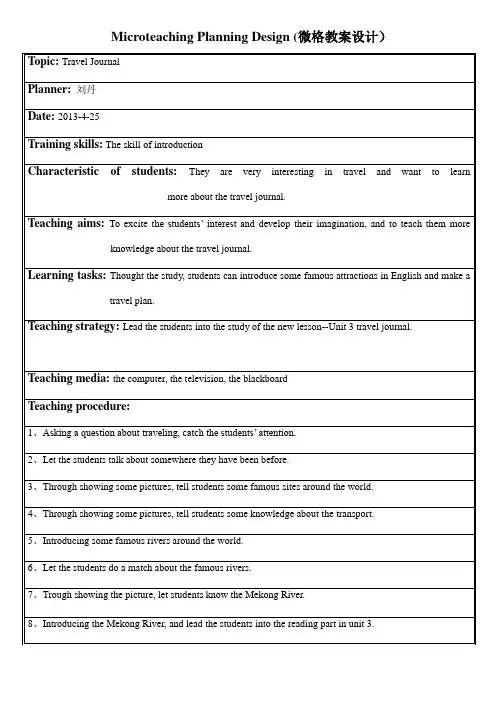
Microteaching Planning Design (微格教案设计)Topic: Travel JournalPlanner:刘丹Date: 2013-4-25Training skills: The skill of introductionCharacteristic of students: They are very interesting in travel and want to learnmore about the travel journal.Teaching aims: To excite t he students’ interest and develop their imagination, and to teach them more knowledge about the travel journal.Learning tasks: Thought the study, students can introduce some famous attractions in English and make a travel plan.Teaching strategy: Lead the students into the study of the new lesson--Unit 3 travel journal.Teaching media: the computer, the television, the blackboardTeaching procedure:1、Asking a question about traveling, catch the students’ attention.2、Let the students talk about somewhere they have been before.3、Through showing some pictures, tell students some famous sites around the world.4、Through showing some pictures, tell students some knowledge about the transport.5、Introducing some famous rivers around the world.6、Let the students do a match about the famous rivers.7、Trough showing the picture, let students know the Mekong River.8、Introducing the Mekong River, and lead the students into the reading part in unit 3.Microteaching Planning (微格教学教案)Subject: EnglishTopic: Travel JournalPlanner:刘丹Date: 2013-4-25Teaching aims: To excite the students’ interest and develop their imagination, and to teach them more knowledge about the travel journal.Time Teaching behavior Teachingskills Learning activities Teaching media30s Good morning, boys and girls.How are you today?I’ m fine, thanks.Today,we will learn the unit 3 traveljournal.Let students beready for newlesson.Good morning, Miss Liu.I’ m fine, and you?OK.1m 1、Before the class, i have two questionsfor you.2、Do you like traveling?3、Where have you been before?Any volunteers? OK, you please.4、That is wonderful! If I have a chance,I want to go there, too. Any othervolunteers? #, please.5、I think you have been many beautifulplaces before, right?To excite thestudents’interest aboutthe newlesson.1、Yes, I do.2、#Beijing, Tianjin#Yunnan, XiamenComputerandtelevision1、And now, i want to show you morefamous tourist attractions around theworld.1、Yes.3m Let’ s guest where is it.Are you ready?2、No.1, where is it?3、Yes. It is the Tienanmen Square inBeijing. And next one? Any one knowabout that?4、It is the Victoria Harbour in HongKong. It is the important part of HongK ong’ s economic. And next one. What isit?5、Yeah, it is the Eiffel Tower. ThanChinese people called it 巴黎铁塔or埃菲尔铁塔.6、I would like to travel there becausethey are so great! Do you?To tell studentssome famoussites around theworld and holdthe students’attention aboutthe travel. 2、Tienanmen Square.3、Hong Kong.4、巴黎铁塔。
高一英语Unit 3 Travel Journal—Using language教案教学目标1.了解旅行日记的写作风格和格式要求。
2.掌握表达旅行经历的常用词汇和短语。
3.学习运用适当的过去时态描写旅行经历。
4.提高学生的写作能力和语言表达能力。
教学重点1.学习旅行日记的写作技巧和格式要求。
2.掌握运用适当的过去时态描述旅行经历。
3.思路清晰、文字连贯的写作能力。
教学步骤第一步:导入新课1.利用图片或小视频引导学生回忆自己曾经的旅行经历,并引发学生的兴趣。
第二部:预习导入1.让学生预读课文并回答以下问题:–What is a travel journal?–What is the purpose of writing a travel journal?–What are some common features of a travel journal?第三步:讲解旅行日记的写作格式和技巧1.根据学生的回答,讲解旅行日记的写作格式要求,包括日期、地点、天气、景点和个人感受等方面的描述。
2.介绍一些常用的表达旅行经历的词汇和短语,并给出示例句子。
3.引导学生练习如何把旅行经历用适当的过去时态描述出来。
第四步:示范写作和讲解1.展示一个范例旅行日记,并解读其写作技巧和语言表达方式。
2.与学生一起分析范例旅行日记,找出其中的亮点和不足之处。
3.强调写作时需要注意的事项,如遣词造句的准确性、语法和拼写错误的避免等。
第五步:练习和讨论1.让学生以小组为单位,互相检查和修改自己的旅行日记草稿。
2.让学生轮流朗读自己的旅行日记,并让其他同学提出反馈和建议。
3.引导学生讨论旅行日记的特点和价值,以及怎样写出一篇出色的旅行日记。
第六步:作业布置1.让学生完成自己的旅行日记,并收集一些关于旅行的图片或照片,准备下节课展示。
教学反思本节课通过导入新课、预习导入、讲解旅行日记的写作格式和技巧、示范写作和讲解、练习和讨论以及作业布置等步骤,帮助学生了解旅行日记的写作要求和技巧,并提升他们的写作能力和语言表达能力。
北师大版高中英语必修一第三单元教案全文共3篇示例,供读者参考篇1Unit 3 Travel journal1. Teaching aims:a. Enable students to master some vocabulary related to travel.b. Enable students to grasp some important sentence structures and expressions.c. Cultivate students' listening, speaking, writing and reading skills.d. Cultivate students' interest in writing travel journals.2. Teaching key pointsa. Key vocabulary related to travelb. Important sentence structures and expressionsc. Writing skills for travel journals3. Teaching difficult pointsa. How to use the vocabulary and sentence structures in practical situations.b. How to write a coherent and interesting travel journal.4. Teaching aidsa. Multimedia resourcesb. Whiteboard and markers5. Teaching proceduresStep 1: Warm-up (10 minutes)a. Show students some pictures of famous tourist attractions around the world and ask them if they have ever been to any of them.b. Discuss with students the reasons why people travel and the benefits of traveling.Step 2: Vocabulary learning (15 minutes)a. Introduce some key vocabulary related to travel, such as "destination", "sightseeing", "accommodation", "itinerary", etc.b. Have students practice using the vocabulary in sentences.Step 3: Listening and speaking practice (20 minutes)a. Play a recording of a travel journal entry and have students listen carefully.b. Ask students to discuss in pairs or small groups about their own travel experiences and share them with the class.Step 4: Writing practice (30 minutes)a. Introduce the format and structure of a travel journal entry.b. Have students write their own travel journal entry about a trip they have taken or would like to take.c. Provide feedback and corrections on students' writing.Step 5: Review and assessment (15 minutes)a. Review the key vocabulary and sentence structures learned in the lesson.b. Have students present their travel journal entries to the class for assessment.6. Homeworka. Ask students to continue their travel journal entries at home and bring them to the next class for review.b. Assign some exercises related to the vocabulary and sentence structures learned in the lesson for further practice.Through this lesson, students will not only improve their English language skills, but also develop a greater appreciation for the art of travel journal writing.篇2北师大版高中英语必修一第三单元教案Unit 3 Travel journalⅠ. Teaching aims and requirements1. Knowledge aims:(1) Get to know some news words: trek, snowcapped, spiritual, kingdom, Kingdom, camel.(2) Understand the main idea of each para., comprehend some detailed information to Mary and Mood.(3) Practice reading skills: skimming and scanning.2. Ability aim:Improve students’ abilities of listening, speaking, reading and wring. Learn how to express travel through it.3. Emotion aim:(1) Cultivate students’ travel mind and prepare their travel ideas.(2) Learn to respect, peaceful and grateful.4. Moral aim:Learn to natural world to love, to know animals and treasure life’s creatures.Ⅱ. Teaching key points1. Summary the passage: Why does Mary Bishop come to the Nepal Himalaya?2. How did she feel after leaving the snow-capped mountain?3. What about another member’s mood?Ⅲ. Teaching difficult points1. Improve students’ summarizing ability.2. Ingrain climate.Ⅳ. Teaching aidsA recorder, a computer and multi-media.Ⅴ. Teaching methodsTask-based teaching. Communicative approach.Ⅵ. Teaching proceduresStep Ⅰ: Lead-in1. Show some cards about the animals and choose the most important animal in their heart.2. Ask: Why do they feel meet?3. Listen to the tape for warming up.Step Ⅱ: Pre-reading.Predict what they may feel during trekking in the Himalayas and give their an example then scan Task1Q1.Step Ⅲ: Reading1. Students read the passage quickly and choose the answer about Mary loses while trekking.2. To teacher’s questions: What’s wrong with Mary’s friend?3. Analyze detailed information of Mood.4. Check the work and ask some questions to each other and fill in the blanks.Step Ⅳ: Comprehension1. Listen to Task2Q2 to particular. They can draw a map to explain that she arrives in Jiri and then to Sethopsar.2. Find the detailed from the passage and fill in the blanks.3. Pair works to discuss mood for 2 minutes.Step Ⅴ: Language practice1. Help student to speak: In pairs. Practice speaking these dialogues.2. To help them to translate Chinese into English.Step Ⅵ: SummaryAsk students to try their best to speak in English about their thoughts when meet animals in trekking.Step Ⅶ: Homework1. Choose another paragraph to summarize.2. Writing an essay with their parents talking about experience of trekking.Ⅶ. Blackboard designUnit 3 Travel JournalMain Idea: Why does Mary Bishop come to the Nepal Himalaya?a) ...........b)...............c)…………Task 1Fill in the blanks.1. The writer saw many ---------.2. There was a dog following the trek who tried to--------.3. In the evening, they camped in a beautiful ---------.Task 2Write down your answers in the passage.1. Travel to Tsomanthang.2. Go to Sethopsar.ConclusionImprove students' summarizing and comprehension abilities.篇3Lesson 3 One's company, two's a crowd, three's a party【Teaching Aims】1. Enable students to master the key words and expressions in the text.2. Improve students' listening, speaking, reading and writing skills.3. Develop students' ability to express their opinions and thoughts in English.4. Cultivate students' understanding of different cultures and social norms.【Teaching Key Points】1. Key words and expressions in the text.2. Listening comprehension.3. Speaking practice based on the text.4. Writing a short paragraph expressing personal opinions.【Teaching Difficult Points】1. Listening comprehension.2. Expressing personal opinions and thoughts in English.【Teaching Methods】1. Task-based teaching method.2. Group discussion.3. Pair work.4. Role play.5. Multimedia teaching.【Teaching Procedures】Step 1: Greeting and warm-up (5 minutes)- Greet the students and introduce the topic of the lesson.- Ask students to discuss in pairs: "What do you think makes a good party?"- Have a brief class discussion to share ideas.Step 2: Pre-reading task (10 minutes)- Ask students to look at the title of the text and predict what it might be about.- Play a short video clip of a party scene and ask students to describe what they see and how they feel.Step 3: Reading and listening (20 minutes)- Read the text aloud and ask students to read along silently.- Play the audio recording of the text for students to listen and follow.- Discuss the main ideas, key words, and expressions in the text.Step 4: Reading comprehension (15 minutes)- Divide students into pairs or small groups to discuss and answer the comprehension questions.- Check the answers as a class and provide feedback.Step 5: Speaking practice (20 minutes)- Divide students into groups and assign roles for a role play activity about planning a party.- Encourage students to use the key words and expressions from the text in their conversations.- Monitor and provide feedback on their speaking skills.Step 6: Writing (15 minutes)- Ask students to write a short paragraph expressing their opinions on the importance of social gatherings.- Collect and review the paragraphs for grammar and vocabulary errors.Step 7: Summarizing and homework (5 minutes)- Summarize the key points of the lesson and ask students to review the text for homework.- Assign a writing task for students to write a party invitation using the key words and expressions from the text.【Teaching Reflection】This lesson aims to engage students in a variety of activities to improve their English skills while exploring the theme of social gatherings. By focusing on listening, speaking, reading, and writing tasks, students are able to practice and consolidate their language skills in a meaningful context. The use of multimedia and interactive activities helps to create a dynamic and engaging learning environment.。
人教版高中高一上册英语《Unit 3 Travel journal》教案一、教学目标1.掌握重点词汇和短语,如destination, culture, historical site, local cuisine, traveler, itinerary等。
2.能够正确理解并运用课文中鲜明的主题,并能够通过口语和写作表达自己的观点。
3.了解一些国家的文化和历史,并通过总结旅游经验和意见,最终能够就出游的目的地和旅游方式进行讨论。
二、教学重点1.掌握目的地选择与旅游路线规划的关键词汇和短语。
2.阅读文本的能力,理解并分析其中的观点和主题。
3.掌握旅游相关的口语表达。
三、教学难点1.教授学生如何就目的地和旅游方式进行讨论并提出有建设性的意见。
2.通过英语听力以及其他资源,向学生展示不同国家和地区的文化和历史。
四、教学方法1.通过小组讨论展开学生的自我表达能力。
2.通过与学生互动,引导他们养成批判和理性的思维习惯。
3.联合多种资源,包括音频、视频等手段,让学生更加深入地了解就目的地和旅游方式进行讨论的相关话题。
五、教学过程1. 目的地选择和旅游方式探究让学生组成小组,为一次旅行选择目的地并提出旅游方式的想法。
鼓励学生使用他们在本单元之前所学的词汇表达出自己的意见。
组长可以对学生提出的想法进行总结,并以此贡献组内的思路。
2. 阅读理解学生可以阅读并分享他们的旅游日记。
这个过程中,教师可以向学生介绍一些世界知名旅游景点,例如埃菲尔铁塔和各种宫殿等。
3. 呈现文化和历史老师可以使用音频、视频等资源,从文化和历史的角度向学生展示不同国家和地区的传统和历史文化。
这个过程可以由教师策划,或者是让学生自己从互联网中寻找其他资源。
4. 小组讨论教师或课堂中的学生可以提出一些讨论题目,让学生在小组内进行讨论并总结共识。
例如:•许多人喜欢去旅游目的地,仅仅是为了照相留念。
对于这种做法,你有什么看法?•众所周知,旅行有许多好处。
《Unit3Travel journal》教学设计
一、教学目标
1.掌握与旅行相关的词汇和表达。
2.能够描述自己的旅行经历或计划。
3.培养学生对旅行的热爱和探索精神。
二、教学重难点
1.重点:词汇和表达的掌握,旅行描述。
2.难点:用英语连贯地描述旅行经历。
三、教学方法
情景模拟法、口语表达法、写作训练法。
四、教学过程
1.导入
展示一些美丽的旅游景点图片,激发学生对旅行的兴趣。
2.词汇学习
(1)教授与旅行相关的词汇,如journey、destination、adventure等。
(2)通过词汇接龙游戏巩固词汇。
3.口语练习
(1)学生两人一组,互相询问对方的旅行经历。
(2)分享有趣的旅行故事。
4.写作训练
(1)让学生写一篇自己的旅行日记或旅行计划。
(2)展示优秀作品,进行点评。
5.课堂小结
总结旅行相关的词汇和表达,以及如何描述旅行。
6.作业布置
(1)制作一份自己梦想旅行地的海报,用英语介绍。
(2)阅读一篇关于旅行的英语文章。
《Unit3Traveljournal》教案高中必修1英语《Unit3Traveljournal》教案高中必修1英语教学预备教学目标1.通过同学共享自己的旅游经受,用英语进行沟通与表达。
2.通过略读与找读,使同学猎取文章主要信息,练习阅读技巧。
3.通过小组争辩为旅游预备的物品,使同学用英语简洁的语言实践活动。
教学重难点教学重点:利用阅读技巧,猎取文章大意及细节教学难点:用英语沟通并进行简洁实践活动—旅游需要预备的物品教学过程I、WarmingUp:1.I’dliketosharemytravellingexperiencewithyou,andwouldyouliketo shareyourtravellingexperience?2.Theworldhasmanygreatrivers.Haveyoubeentotheserivers?设计意图:大部分同学都宠爱旅游,老师谈谈自己旅游的经受,询问同学的旅游经受。
列举世界上有名的河流图片,让同学来观赏生疏奇特的河流。
能有效地调动同学的学习乐观性。
河流图片的呈现,同学猜想河流的名字,唤起同学的学习爱好以及对大自然的宠爱。
II.Pre-readingHaveyoubeentotheMekongRiver?WhatcountriesdoestheMekongRiver flowthrough?设计意图:呈现沿湄公河的地图,引起同学的爱好,让同学观看地图,说出湄公河流经的国家,为随后的阅读做好了内容和词汇上的铺垫。
III.Reading1.SkimmingSkimthepassageandfindthemainideaforeachparagraphPara1:DreamPara2:AstubbornsisterPara3:Preparation设计意图:略读:同学快速扫瞄课文,查找相关信息并搭配段落大意。
点拨阅读技巧:留意每段开头及结尾。
2.Scanning1).ReadPara1andfindthekeywordfortheinformation:WhoandWhatWhereandHowWhyandWhen设计意图:1.查找who,what,where,how,whyandwhen等关键信息,让同学把握这类记叙文的阅读要点。
Unit3 Travel Journal1. 教材分析本单元的中心话题是“旅游”,通过旅游日记的方法描述旅游见闻。
【课标内容】语言技能:听:准确掌握听力材料中的升调和降调,迅速获取文章中的旅行方式、旅行路线以及时间、地点、人物等重要信息。
说:用地道、规范的句子向别人告别或表达祝愿;能够熟练使用现在进行时表述自己对未来的打算。
读:阅读本单元课文及相关旅游文章,能够从文章中获取主要信息,克服象地点名、民族名,民族特点的节日名称的障碍。
写:能够写一篇游记,要求做到:思路清晰,语言简练,并能正确表达自己所做之事、所到之处以及自己的感受。
语言知识:学习本单元新单词、新短语以及用现在进行时表示将来含义的用法。
话题:Travelling; describing a journey词汇:见教材词汇表功能:1.祝愿和告别(Good wishes and farewells)1).Have a good day/ time/journey/trip!2).Good luck! Enjoy yourself! Best wishes to you!2.交通方式 (Means of transportation)walking, cycling, horse riding, takingbuses/trains/boats/plane语法:现在进行时表示将来When are you leaving?How long are you staying there?情感态度:通过课文的学习,要求同学们能够积极参与关于旅行准备、旅游见闻、旅游感受等方面的交流活动,用准确的英语描述国内外的重要景观、名胜古迹以及一些当地的旅游文化节日。
学习策略:1、资源和交际策略。
通过多种渠道获取更多的与旅游相关的语言信息,从而扩大语言输入量,形成语言运用能力。
2、借助联想,建立相关知识间的联系。
文化意识:体会“读万卷书,行万里路”的旅游文化效益。
Unit3 Travel journal
一、教材的地位和作用
本单元讲述了主人公以旅行日志的形式详细地记录一段沿湄公河而下的自行车旅行经历。
学生通过追随这一段旅程,探讨与“旅游”相关的各种话题。
通过本单元的学习,不仅可以使学生学到与旅游有关的语言知识和技能,还会使学生对旅游产生浓厚的兴趣,通过旅行了解世界各地的文化,增加对祖国大好河山的热爱和国际意识,进而培养学生的跨文化际能力。
二、学情分析
高中一年级的学生已经在初中阶段的英语学习中,已经积累了一定的词汇基础,并掌握了一些简单的学习策略和技巧,具有初步的英语听说读写能力。
但是,学生个性和英语水平差异大,因此教学设计要有梯度,由浅入深,注意层次性。
英语作为一门语言,其最基本的作用就是人际交流。
但是中国学生普遍的情况是不愿开口说英语。
因此我在课堂要鼓励学生们利用每个机会开口说英语,以达到锻炼口语的目的。
三.教学目标
根据《新课程标准》的要求和学生已有的知识基础和认知能力,在仔细学习和分析教材的基础上,我确定了以下教学目标。
四.教学重点和难点
1.重点:学会制作旅行计划;学会用现在进行时表将来的方法。
2.难点:提高学生口语运用能力和合作学习的能力。
五.教学方法
根据高中生的心理特点,宜采用形式多样的教学方法和学生积极主动参与的学习方式,激发学生的学习兴趣,让他们在学习中学会参与,在参与中学会学习。
因此我采用了以下几种教学法。
(1)任务型教学法
(2)合作学习法
六.教学过程
Step1 Lead in 导入
学习这节课时,学生们不久前正好从国庆节休假回来,可以充分利用这个机会,以两人对话或小组的形式来讲述每个人旅行经历,有条件的话可以和大家分享照片和视频,让他们也可以感受其中的乐趣并了解更多的旅游知识,从而引入本节课的主题:旅行计划以及旅行前的准备。
设计意图:旅游是学生比较感兴趣的话题,用这个和学生生活密切相关的话题和经历来引起学生的学习兴趣和热情。
Step2 Warming Up热身
(1)列举比较常见的几种交通工具,并让学生小组讨论说说这些交通工具有哪些优点和缺点。
(2)让学生策划一次自己的旅游活动。
我会在语言上和内容上对他们进行指导。
利用这个机会介绍本课的重点语法:现在进行时表示将来。
指导性的问题如下:
●Where are you traveling to?
●How are you getting there?
●How much are you spending on it?
●What are you taking with you for your trip?
设计意图:让学生对旅行前的筹划有所认识, 让学生在活动中学习语法知识,增加他们的学习兴趣。
Step3 Pre-reading 读前
1. 给学生展示一张河流的图片,然后让学生猜测本单元要阅读的旅行故事可能与什么有关。
学生很快会得出正确答案:河流。
我会接着问:
●Why would people want to see rivers? What do rivers provide?
●How do people make use of rivers in their daily life?
2.给学生展示第二张关于湄公河流经地区的图,让学生观察河流流向与途经的国家,再介绍一些关于湄公河的背景知识。
中国(China)、老挝(Laos)、缅甸(Burma)、
泰国(Thailand)、柬埔寨(Cambodia),越南(Vietnam)
设计意图:一方面让学生对主人公旅行的路线以及见闻有一个大致的了解,从而更好的理解课文,另一方面也启发学生关注途经国家的文化信息,增强文化意识。
Step4 While-reading 阅读中
(1)讲解生词:
考虑到文中的生词(即黑体部分)可能会影响学生对文章的理解,因此我会先给学生粗略讲解下这些生词的意思。
Ever since, persuaded, cycling, graduating, finally, schedule, fond of, shortcoming, stubborn, organize. Care about, determined, change her mind, journey, altitude, made up her mind, give in, valleys, pace, bends
(2)Skimming(略读)
让学生通读全文,利用刚刚学过的语言知识和背景知识来理解文章内容,了解文章的大意。
(3)Scanning(找读)
让学生再次通读全文,找出以下问题的答案:
●What was Wang Kun and Wang Wei’s dream?
●What can they see when they travel along the Mekong river?
●Will they have some difficulties in their journey? What are they?
(4) 小组讨论
小组讨论Wang Kun和Wang Wei在这次旅行中的态度。
设计意图:训练学生基本的阅读能力和技巧以及表达观点的能力。
Step5 Post-reading 读后
1. Retell the text using the words you have just learned.
2. Work in pairs to make up a dialogue using the information from the passage. 设计意图:培养学生的语言组织和表达能力。
Step 6 Homework
1. Review and remember all the new words
2. Write a journal about your last travel。
设计意图:复习和巩固所学知识。
八.板书设计。